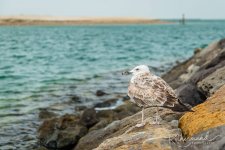A non-birder friend of mine photographed this gull yesterday and asked me for identification. Trouble is I'm rubbish at gulls. The default taxon here is barabensis - heuglini is more commonly found on the east coast. Caspian also occurs but we're unsure of numbers because of ID difficulties. The sloping forehead is interesting on this bird, but the bill is very heavy and bulbous. Any ideas?
Thanks in advance,
Andrew
Thanks in advance,
Andrew





